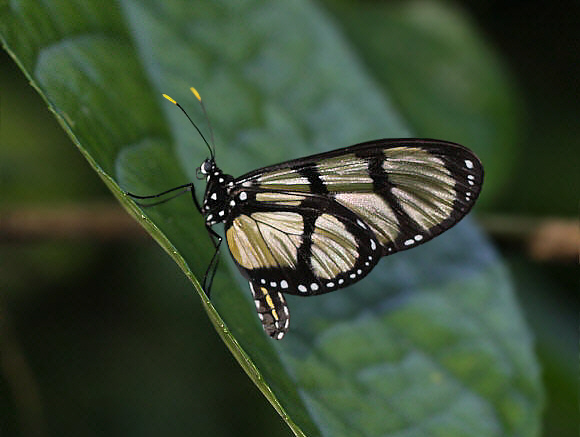
Introduction
The Ithomiini comprises of 376 known species, although it is likely that at least another 30 will be discovered in the near future. All are confined to the neotropical region. Ithomiines are unpalatable to birds, and are consequently mimicked in appearance by many other species. These include other unpalatable species ( Müllerian mimics ), not only from the Ithomiinae but also from several other butterfly families. There are also a large number of edible species ( Batesian mimics ) which have evolved similar patterns. Birds have the ability to memorise butterfly patterns and so learn to avoid eating noxious species, but are also fooled into ignoring similarly marked edible species.
Ithomiines are characterised by having small eyes, slender abdomens and long drooping antennae that lack distinct clubs. Males have a plume of long androconial scales or “hair pencils” on the costa of their hindwings. These are hidden from view when the butterflies are at rest, but are displayed when the wings are held open during courtship. Other Ithomiine characteristics include a very slow and deep wing beat, and a preference for inhabiting the darkest recesses of the forest understorey.
There are basically 2 types of Ithomiine. The first type are the black and orange-banded “tigers”, many of which are mimicked by other species due to their unpalatability to birds. The second type are the “glasswings”, recognised by their transparent or translucent wings, prominent veins, and orange wing margins. Many genera contain examples of both of these types, and in some cases an individual species may produce adults of both forms according to location.
Most novices find the Ithomiini very difficult to identify. Using only the patterns to identify species is very unreliable because there are so many similar species. Also many species produce a variety of different colour forms according to locality and season. The best approach therefore is to use the hindwing venation and other anatomical features to identify the genus, and to then look at the wing patterns to short-list the likely species.
The Giant Glasswings, which have wingspans of about 90-100mm, include 7 species of Methona and a single species of Thyridia. The 2 genera can be distinguished by the position of the dark cross-bar on the hindwing, which in Methona is further out from the base. Thyridia also have shorter antennae and in newly emerged specimens the hyaline areas have an orange tinge, but this fades after a day or two and becomes similar in hue to the creamy translucency of Methona.
The illustrated subspecies Thyridia psidii ino is distributed Ecuador to Peru and Bolivia. The Central American subspecies melantho which is distributed from Guatemala to Panama has much heavier black markings on the forewings, and has orange-red hindwings in which there is a prominent black spot at the end of the discal cell. There are intermediate forms in Venezuela and elsewhere which are marked like ino but have a translucent orange ground colour.
Habitats
Thyridia psidii inhabits disturbed rainforest and cloudforest at altitudes between 0-1600m.
Lifecycle
The egg is large, globular and white. Females sometimes spend up to an hour fluttering within a metre or two of the chosen oviposition site, before finally laying an egg on the underside of a leaf.
When fully grown the larva is translucent greenish-blue with yellow tubercles along the sides of the abdominal segments. It feeds on Cyphomandra ( Solanaceae ).
Adult behaviour
Thyridia psidii normally flies at a height of 3 metres or more above ground level. Males are active mainly in the mornings, but females can be seen gently floating across narrow sunlit trails in the forest during the middle of the day. The butterflies are nearly always seen singly. Both sexes visit Lantana, Hamelia, Inga and Carica flowers for nectar.
